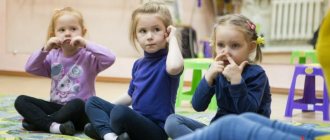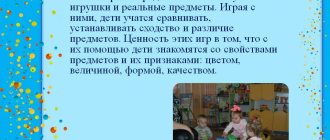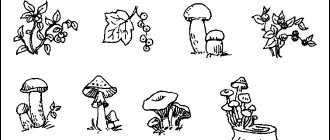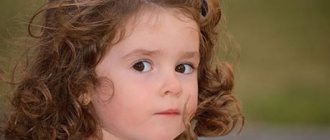Article:
Logorhythmic games are games aimed at developing motor skills and pronunciation.
They include music, movement and play activities. Logorhythmics classes are present in any teaching activity in preschool institutions, as well as at school. In the exercise card you can find classes for different ages and groups. Logorhythmic games are of particular importance for children with disabilities. Knowing the characteristics of children, you can choose appropriate exercises appropriate to their age and development.
Logorhythmic games should be performed at a certain time every day.
Logorhythmic games for children 4-5 years old
By the age of 4-5 years, the final development of speech occurs. It is important to pay great attention to the pronunciation of sounds and strengthening the articulation of sounds. Therefore, speech therapy exercises at this age occupy a special place.
The horse runs tsk-tsk-tsk, (clicking movements of the tongue from the palate)
A bird chirps in a field. (same clicking noise but from teeth)
A friend is sitting on the bank (smile, teeth unclenched)
And catches a fish in the sea (they close and straighten their lips)
Breathing continues to develop. Speech breathing should be distinguished from the general one. You can perform exercises for alternating short and deep breathing:
Doll Masha wants to sleep. (inhale through your nose, exhale with a drawn-out sound “ahhhh”)
Let's sing her a song. (inhale through the nose, on one exhale repeat the syllable “la-la-la” three times)
Doll Masha fell asleep. (sniffle)
The right time for such exercises would be gymnastics after an hour of sleep. Together with general motor skills, fine motor skills are actively developing. It is worth adding acting skills to logorhythmic games and exercises, teaching children to get used to the role and operate with various phrases:
- I am a cheerful cockerel (inhale, exhale “ko-ko-ko”)
I have a comb. (shake head)
— I am a frowning turkey (inhale, exhale “pa-pa-pa”)
I'm looking for grains bale-bale (tilt my head as if pecking at the grains)
- I’m a mischievous horse (clicking tongue from the roof of your mouth)
Golden tail and mane (shake your head)
The expressiveness of movements should correspond to the emotional state of the hero. Children learn to manage their emotions and express them correctly. You can change the exercise words as you play. Let the children do it themselves, do not interfere with their imagination. When the children learn the words, let each of them do the exercises one by one.
Game 1
A good game would be to guess your classmates. It develops tactile sensations, general motor skills and rhythm: children stand in a circle, and one child in the center. He is blindfolded. The children begin to walk in circles. The teacher says “stop” and the children stop. The child in the center of the circle approaches one of the children in the outer circle and guesses who it is.
Game 2
A popular game for this age is “Sea Figure, Freeze!” Children take on the role, play actively, learn to listen to music and quickly respond to brake lights. Freezing in certain positions reinforces knowledge about the capabilities of your body.
Top full-time courses
Retraining of speech therapists is carried out by many different organizations, but not all of them use full-time or part-time training. Most often, universities or some training centers in large cities that have the necessary material and technical base and human resources can afford this. Among the universities whose programs include the study of logorhythmics, the following can be noted.
| Name and location of the educational institution | Features of the program | Cost of education |
| Siberian Federal University (Krasnoyarsk) | On the basis of the Lesosibirsk branch and the Resource Center in Zheleznogorsk Siberian Federal University, you can complete the retraining program “Preschool Pedagogy and Psychology” with a volume of 255 or 510 academic hours, part-time or part-time. After this, you need to complete the advanced training course “Innovative technologies in preschool education” lasting 72 hours to gain practical skills. | Information available upon request |
| Russian State Vocational Pedagogical University (Moscow) | At RSPPU you can choose a full-time or correspondence retraining course “Defectology and Speech Therapy” with a volume of 520 hours, which is conducted by the Institute of Continuing Education. | Information available upon request |
| Novgorod State University named after. Yaroslav the Wise | The university has a professional retraining course “Special (defectological) education. Speech therapy. Oligophrenopedagogy”, which provides extensive knowledge on correctional work with children. Its labor intensity is 570 hours, it is conducted in a part-time format, and remote technologies are actively used. | 30,000 rubles |
| Kaluga State University named after. K.E.Tsiolkovsky | Among the university’s developments, one can highlight the retraining course “Organization and content of speech therapy work.” The curriculum is designed for 520 academic hours; students master all the material part-time and part-time in 8 months. Among the special disciplines of the program, participants will receive practical skills in organizing logarithmic work with children. | 25,600 rubles with the option of paying 3,200 rubles monthly |
| Moscow Pedagogical State University | The Institute of Childhood at Moscow State Pedagogical University has several suitable programs for a future specialist in logorhythmics. First of all, this is “Speech Therapy” (full-time for 10 months or part-time for 1 year 3 months). You can also pay attention to the ten-month course “Preschool defectology”. All these programs have a labor intensity of 1332 academic hours. Classes are held 2–4 times a week in the evenings and also on Saturdays. | 80,000–120,000 rubles depending on the chosen course |
In these same universities you can choose a suitable advanced training program in various aspects of logorhythmics. You can also agree with the teacher about additional lessons if he practices such techniques in his work. Having received the necessary qualifications, all that remains is to figure out the specialization - and you can start working.
Logorhythmic games and exercises for children 5-6 years old
At this age, children, as a rule, already speak well and know how to control their body. The child's body is full of strength and energy. Active games and exercises that require physical effort are suitable. To prepare for beautiful handwriting, logarithmic exercises for fine motor skills and self-massage (rubbing palms, fingers, acupressure exercises) are used.
It’s not for nothing that winter is angry, (shaking index finger)
Its time has passed. (rubbing palms)
Spring is knocking on the window (knock on the palm with a finger)
And drives them out of the yard (waving their arms, driving away winter) (F. I. Tyutchev)
Logorhythmics at this age should be aimed at developing a sense of rhythm and emotion in speech, and correct intonation. At 5-6 years old, you need to teach your child smooth speech and voice, and continue to develop breathing. During the year there is active preparation for school. With the help of logorhythmic exercises, attention and concentration are developed.
Transitions of music tempos from slow to fast and back are relevant at this age. To gain a sense of rhythm and tempo, you can let children play musical instruments themselves and beat out a simple rhythm together, for example, on spoons and tambourines. In the older group, exercises are of a regulatory nature. Teach children independence. Exercises where the child himself must guess what movement needs to be made at the moment are well suited for these purposes. For example, when you hear the words “snowflakes are spinning,” you need to spin around with your arms out to the sides:
All the snowflakes are whirling in the wind, (whirling)
Without doubts and worries. (jump, breathe through their nose)
So we guys are together (holding hands)
Together we will stand in a round dance (they walk a circle in a round dance) (M. A. Mordvin)
The help of a teacher is required when performing the exercises for the first time.
51650_oro.docx
CARD INDEX OF LOGORHYTHMIC GAMES FOR SENIOR PRESCHOOL CHILDREN “STEAM LOGO” card No. 1 Objectives: consolidate the skill of fractional steps with moving forward. Development of imagination and creative abilities of children. The locomotive is moving, moving. He took us to the autumn forest. We are going, we are going faster. A hundred friends are coming with us. How to play: Children stand one after another, arms bent at the elbows, fingers clenched tightly into fists. It is more comfortable for your legs to be slightly bent at the knees. An adult suggests going on a trip. The rhythmic movement of a fractional step is performed throughout the entire text, with the tempo of its execution accelerating towards the end of the game. Methodical recommendations: the text is pronounced very easily, rhythmically, with acceleration. You should pay attention to the good straight posture of children, and also monitor. Keep the step short and not shuffling. The game can be continued by inviting the children to get out of the carriages and walk through the forest, picking flowers, berries, or picking bouquets of colorful autumn leaves. “TO THE FOREST FOR BERRIES” card No. 2 Task: development of coordination of movements. Progress of the game: Let's go into the forest to pick berries, (walk) We'll pick a lot of berries. (imitation of picking berries) Oh look, here are raspberries, (look around and spread their hands) Here are lingonberries, blackberries. There are so many berries that we can’t count them all (they point with a finger and count) We can’t count them all. (nod their head from side to side) “Musical instruments” card No. 3 Task: developing a sense of rhythm and attention. Progress of the game: Play the tambourine, hit, hit, hit, hit more fun. Ring the bell, call us guests. Together we will take the spoons and start playing on them. We will knock on the drum, loudly, loudly. One, two, one, two. It's time for us all to play. (at the beginning the instruments sound alternately. At the end all together) “RAIN, LAY! » card No. 4 (Russian folk nickname) Task: development of the emotional sphere, coordination of movements. Progress of the game: Rain, pour, pour, pour. They wave their hands at me and at people. Hands to the chest and spread to the sides For people, one spoon at a time, palms folded into “spoons” - indentations For me, crumbs at a time, hands to the chest and fingers folded into a pinch And for Baba Yaga Grab your head with your hands, shake your head Lei a whole bucket. Throw your arms down with your torso tilted “SUN” card No. 5 Objectives: To consolidate the skills of performing simultaneously “springs” and claps, jumps and claps. Progress of the game: \ Sunny, \ sunshine, / Look out the\ window: \ Your children\ are crying, / They are jumping over the pebbles. Progress of the game On the 1st and 2nd lines of the test, the adult and the children perform frequent half-squats - “springs” - and at the same time clap their hands. To the text of the 3rd and 4th lines, jumping is performed with simultaneous clapping of your hands. Methodological recommendations: the text is pronounced at a slow pace, in a chant, with a pronounced metrical pulsation, without stopping, acceleration or deceleration. A descending intonation of the voice occurs on each strong beat: \ Sunny, \ sun, / Look out the window, etc. “START A ROUND DANCE” card No. 6 Objectives: To develop a sense of rhythm, strengthen the skill of moving in a circle. How to play: Start a round dance in the center of the circle - a child playing the harmonica. Around the accordion - children, holding hands, walk around it Above the handle, stop, raise their hands up Clap their hands, clap their hands once. Top-top, legs! They stomp their feet 4 times. The exercises are repeated, another child plays the harmonica. “THE FROGS AND THE GUYS” card No. 7 Task: developing a sense of rhythm. Progress of the game: The frogs are all in the puddles Slap-slap-slap, the children do slap-slap-slap! on the knees And the guys along the path - To-tomp-tomp, tomp-tomp-tomp! Foot stomp. They walk happily side by side, sing a song together: La-la-la, la-la-la! They clap their hands “CLAP-SLAP” card No. 8 SL. FOLK Objectives: developing a sense of rhythm, coordination of movements in accordance with the tempo of the music. Progress of the game: starting position - with legs wide apart, children sit on the floor. / Clap once, clap for the word “clap” / Once again, hit the knees with the palms for the word “one” / We fuck, pop, now repeat the movements And then quickly, quickly, rhythmically hit the palms on the floor Spank, spank more fun. Methodical recommendations: the first three lines are pronounced with a pronounced rhythmic pulsation, the descending intonation of the voice falls on each strong beat. The last two lines are spoken at an accelerated pace. “TRA-TA-TA” card No. 9 RUSS. FOLK NUMEROUS Objectives: Development of gross motor skills, coordination of movements. Waste! Waste! Children clap their hands. A cat marries a cat! For the cat Kotovich, they slap the knees with both hands at the same time For the cat Petrovich! They slap the knees with both hands, alternately. Methodological recommendations: the text is pronounced slowly rhythmically, in a chant. In the first line, hand claps occur on each strong beat: \ waste - \ ta, etc. “JUMP” card No. 10 Objectives: to develop the expressiveness of performing light jumps, a soft spring step. Leap, hop, hop, move forward A young blackbird, jumping along the water, walking with a soft spring found a young one. Step Young, narrow the circle Small, / Herself about an inch, sit down Head with a pot. put their palms to their cheeks and shake their heads. Progress of the game Children stand in a circle, arms bent at the elbows, fists pressed to their shoulders - imitating wings. There is a bird (toy) in the center of the circle. Methodological recommendations The text of the game is pronounced slowly, the intonation of the voice rises and a short pause is made.
Logorhythmic games for children who stutter
Logorhythmic exercises for children with stuttering include complexes that strengthen muscle tone, articulation, and diaphragmatic breathing. All exercises must be agreed upon with a speech therapist. Children with speech impairments require a special approach, cannot master musical exercises in full, and require repeated repetition of rhymes and songs. Be sure to pronounce each sound:
The children have a doll in their hands. They clearly pronounce the sounds with the correlation of the action in verse to the doll:
Masha washed Mila with soap.
Exercise:
We put a lock: (smile, teeth closed)
The tongue couldn't get through. (tongue rests on teeth)
The main goal of such games for children with stuttering is to develop the tempo of speech, the rhythm of movements, the smoothness of the voice and coordination in a static and dynamic position. In addition to the speech therapy part, the classes are socially adaptive in nature. They teach behavior in a team, develop the emotional-volitional sphere. This includes activities that transition from a slow walk to running:
Early in the morning they go to visit -
Only best friends. (hugs with a classmate standing next to him)
Turtle with a thick cane
It was not in vain that I set off on my journey. (slowly raise their legs, imitate a step)
The little squirrel called all the animals,
I distributed invitations. (bows in different directions)
Mouse, bear and little rabbit (mouse - walk on tiptoes, bear - clumsily, little rabbit - jump)
They dressed up like they were going to a ball. (make a bell with your hands)
The fox is running as fast as he can - (imitate running)
After all, you can't be late. (they shake their index fingers alternately)
To dance around
Sliding smoothly across the floor. (spinning)
(M. A. Mordvin)
From smooth hand movements to fast ones:
They barely tilt
They ate the tops of their heads straight to the ground. (slowly swing your arms up and down while leaning forward)
A bird flutters in the sky,
Like an eyelash above an eye (stand on tiptoes, quickly wave your arms)
(M. A. Mordvin)
It is advisable to perform the exercises with a music teacher accompanied by live music that is not distorted by the recording. Acting games are performed together with the teacher. First, collective performances or performances without the children’s words are performed, then each child is invited to learn his own words and act out a short story. Words must be selected strictly according to the characteristics of each child and have a focus on those parts of pronunciation that require increased attention. Thus, a collective lesson turns into an individual one.
Relaxation exercises are performed in conjunction with exercises that require increased load. Such games and activities should alternate. The relaxation exercise should be proportionally equal to the load received by the children in the previous game.







